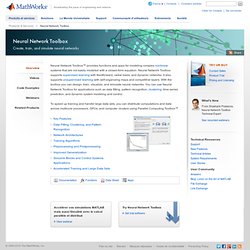

Neural Network Toolbox - MATLAB. Neural Network Toolbox™ provides functions and apps for modeling complex nonlinear systems that are not easily modeled with a closed-form equation.

Neural Network Toolbox supports supervised learning with feedforward, radial basis, and dynamic networks. It also supports unsupervised learning with self-organizing maps and competitive layers. With the toolbox you can design, train, visualize, and simulate neural networks. You can use Neural Network Toolbox for applications such as data fitting, pattern recognition, clustering, time-series prediction, and dynamic system modeling and control. To speed up training and handle large data sets, you can distribute computations and data across multicore processors, GPUs, and computer clusters using Parallel Computing Toolbox™. Neural Networks. Abstract This report is an introduction to Artificial Neural Networks.

The various types of neural networks are explained and demonstrated, applications of neural networks like ANNs in medicine are described, and a detailed historical background is provided. The connection between the artificial and the real thing is also investigated and explained. Finally, the mathematical models involved are presented and demonstrated. Contents: 1. 1.1 What is a neural network? 1.2 Historical background 1.3 Why use neural networks? 1.4 Neural networks versus conventional computers - a comparison 2. 2.1 How the Human Brain Learns? 2.2 From Human Neurones to Artificial Neurones 3. 3.1 A simple neuron - description of a simple neuron 3.2 Firing rules - How neurones make decisions 3.3 Pattern recognition - an example 3.4 A more complicated neuron 4. 4.1 Feed-forward (associative) networks 4.2 Feedback (autoassociative) networks. Introduction to Neural Networks. CS-449: Neural Networks Fall 99 Instructor: Genevieve Orr Willamette University Lecture Notes prepared by Genevieve Orr, Nici Schraudolph, and Fred Cummins [Content][Links] Course content Summary Our goal is to introduce students to a powerful class of model, the Neural Network.

We then introduce one kind of network in detail: the feedforward network trained by backpropagation of error. Lecture 1: Introduction Lecture 2: Classification Lecture 3: Optimizing Linear Networks Lecture 4: The Backprop Toolbox Lecture 5: Unsupervised Learning Lecture 6: Reinforcement Learning Lecture 7: Advanced Topics [Top]
Neural Networks. Artificial neural network. An artificial neural network is an interconnected group of nodes, akin to the vast network of neurons in a brain.

Here, each circular node represents an artificial neuron and an arrow represents a connection from the output of one neuron to the input of another. For example, a neural network for handwriting recognition is defined by a set of input neurons which may be activated by the pixels of an input image. After being weighted and transformed by a function (determined by the network's designer), the activations of these neurons are then passed on to other neurons. This process is repeated until finally, an output neuron is activated. This determines which character was read. Like other machine learning methods - systems that learn from data - neural networks have been used to solve a wide variety of tasks that are hard to solve using ordinary rule-based programming, including computer vision and speech recognition.
Background[edit] History[edit] Farley and Wesley A. Models[edit] or both. Neural network.